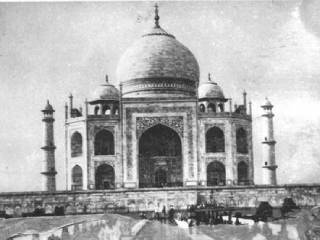The late Pramod Mahajan made one misjudgment in persuading the BJP to hold general elections months in advance on the grounds that India was doing phenomenally well in industrial and economic progress and should cash in on it. His mantra was "Shining India". It was true of some urban areas but did not by and large hold good in rural areas – witness the hundreds of farmers’ suicides. The fact is that for all the progress India is making, it is way, way behind China. Consider these plain facts: China’s foreign reserves at the beginning of December 2006 were of the order of $987.9 billion or almost a trillion dollars. India’s reserves hardly amount to a fraction of it or about $ 160.2 billion.
It may be argued that China had a lead in this regard because it liberalized its economy long before India did, but many will forget the time when India had to pledge its gold to keep its economy going to the country’s eternal shame. Again, China’s trade balance at the end of the year was $ 155.2 billion in its favour while India had a trade deficit of $ 45 billion. In other words, India owes money while China is a creditor – and that maker all the difference. Up to the second quarter of 2006, India’s GDP grew by an impressive 8.9 per cent while China’s more up-to-date figures show even more breath-taking a growth of 10.4% upto the third quarter of 2006.
According to The Economist "India’s trend growth rate has almost certainly increased but it is still nowhere near as high as China’s ". The point that the weekly makes is that "India cannot grow as fast as China without inviting inflation because of its lower investment rate, particularly in infra-structure and labour bottlenecks". According to government figures quoted by the journal, for the year ending March 2005, total investment in India was 30 per cent of GDP, compared with over 45 per cent officially reported in China. China has long been in the habit of doing things on a spectacular scale. The Three Gorges Dam project in China is an excellent example. Shanghai is dazzling and now China has built the Qinghai Tibet Railway (QTR) which is in a class by itself. As early as in the first decades of the 20th century Sun Yat Sen had visualised such a railway but at that point in time China neither had the expertise or the financial strength to undertake so huge a task. According to defence experts, the QTR project is particularly threatening to India and both militarily as well as economically, the network has the potential of isolating India in its backyard.
As Strategic Affairs – a new journal put it, the mainland China- Tibet railway link "has the potential to enable China to further tighten up its grip on the border territories it lays claims on "and arm-twist India into making awesome concessions. According to this journal" in a master-stroke, Beijing has already activated the China-Tibet-Nepal Chamber of Commerce in Lhasa and looking to set up a clone in Bangladesh to accommodate the commercial spillover from the QTR project". There is a general feeling among a certain class of analysts that China is out to demoralise, if not subjugate, India economically, if not politically. What has been India’s response so far? According to available reports, the Indian government has finalised 27 projects for the construction of new roads in the India-China border area over the next four years at an estimated cost of Rs. 900 crores. Additionally, it would seem, apart from constructing 862 Kms of new roads, the government is also examining the proposals for roads along the India-Nepal and Indo-Bhutan borders.
Two questions arise: why would China want to attack India? Again, why should not India be able to face any Chinese threat considering that mainland China is further away from Tibet than India is? Yes, we lost a war with China that was not of our making, but why are we suffering from an inferiority complex even now? Surely the days are gone when a vicious Mao Tse tung could order his forces to: march down to the Assamese plains and get away with murder. That does not mean that we have to trust Beijing’s implicitly. But the trouble with India seems to be that it is constantly worried about foreign invasions, given its long and painful memories of history. In the circumstances it is constantly on the defensive and thereby weakening the Indian resolve to fight back with vigour. What is advantageous to China can be equally advantageous to India, if we look at the QTR from another vies point. Will China use the QTR network to make a significant impact on Sino-Indian border trade? Is the idea to undercut India? If that is the intention, said or unsaid, India surely can fight on similar lines in a trade war? It is claimed that the QTR will enormously boost the Tibetan economy by linking it with mainland China would that be disadvantageous to India? One way of looking at the QTR is that it is a Chinese attempt to demolish the individually of the Tibetans by colonizing them – a point that the Dalai Lama has already taken note of.
One thing is clear: no matter how much we respect the Dalai Lama, China will never allow him a place under the Tibetan sun. Already, a new Tibet is under way and it is anybody’s guess whether a new generation of Tibetans would want to go back to the days when the Dalai Lama held an unquestionable sway over the masses. But one should, at the same time, never forget the military consequences of China’s getting closes to the Indo-Tibetan border. It is claimed, for instance, that the Chinese listening facilities that are coming up in occupied Aksai Chin get cover from two massive helipads that can station four helicopter squadrons. The posts are reportedly for monitoring Indian deployments in the region, eavesdrop on forward movements and intercept army intelligence. Says Strategic Affairs: "China’s repositioning of its missile bases in Tibet and news of a South Korean company using the cover of providing technical assistance to set up new command and control posts should make India set up and take notice particularly of the news that China has deployed 20 Medium Range Ballistic Missiles (MRBMs) and sixty short range surface-to-surface missiles targeting Srinagar, Chandigarh, Shimla, Ambala and Jalandhar and vital military installations in the region".
No one can say that India has not been forewarned. But what is China up to? A third World War? A way of arms-twisting India for the latter to give up territory it claims as its own? Would a major war be fought for so petty a purpose? But then it is anybody’s guess. But it is not unwise to look at all possibilities and plan to meet them effectively. There was a time when we trusted China implicitly. The Nehru government was naive. We have, hopefully, grown out of that mind-set. We have to be cautious of complacency and surely we have matured, after all the ups and down we have seen in sixty years of independence.
http://www.samachar.com/features/
110107-features.html

 Mizoram: EC accepts Christians’ demand to defer counting on Sunday, but what if Hindus had made a similar demand?
Mizoram: EC accepts Christians’ demand to defer counting on Sunday, but what if Hindus had made a similar demand? Sign Petition : Immediately repeal the draconian and unconstitutional ‘The Waqf Act, 1995’
Sign Petition : Immediately repeal the draconian and unconstitutional ‘The Waqf Act, 1995’ Shriram : Sri Lanka’s saviour
Shriram : Sri Lanka’s saviour Why it is so cool to malign Hindu gods and goddesses, but it may not be that easy now
Why it is so cool to malign Hindu gods and goddesses, but it may not be that easy now Shocking Truth of Taj Mahal exposed by Late Pujya P. N. Oak
Shocking Truth of Taj Mahal exposed by Late Pujya P. N. Oak How are Hindus treated in states where they are in a minority?
How are Hindus treated in states where they are in a minority?